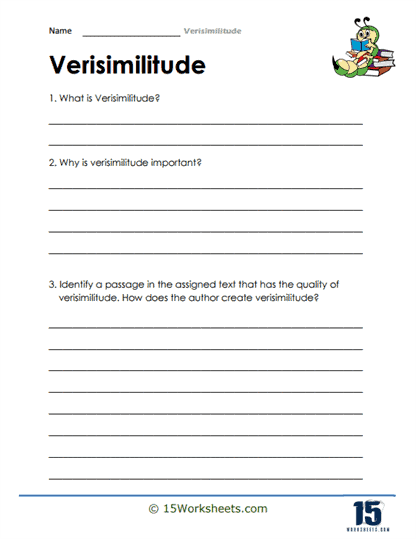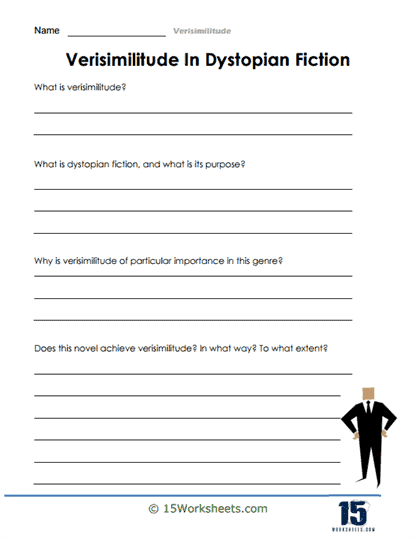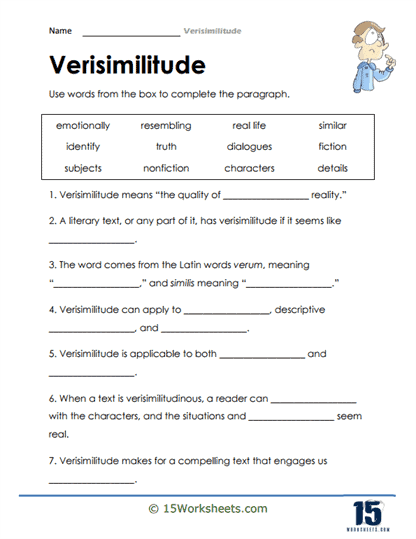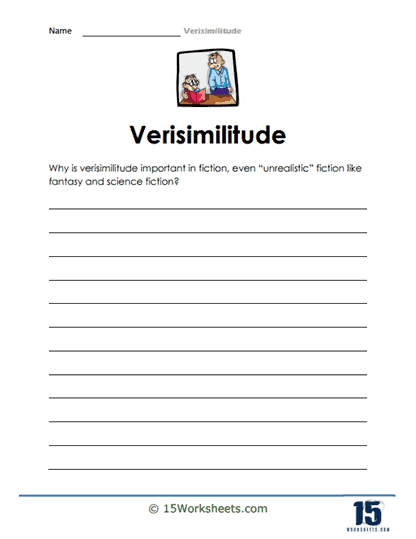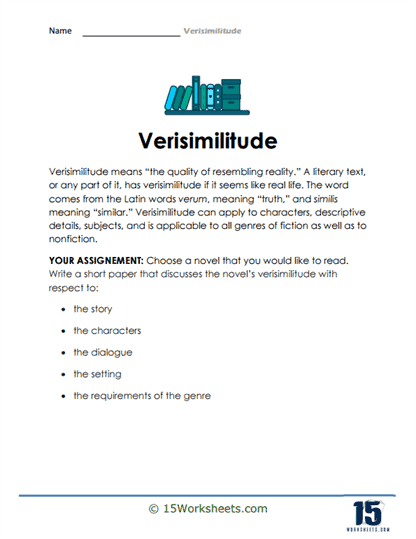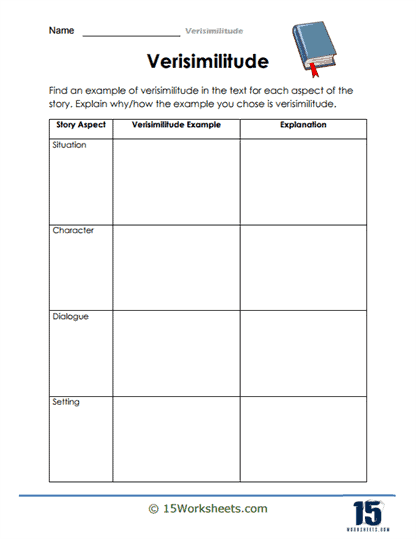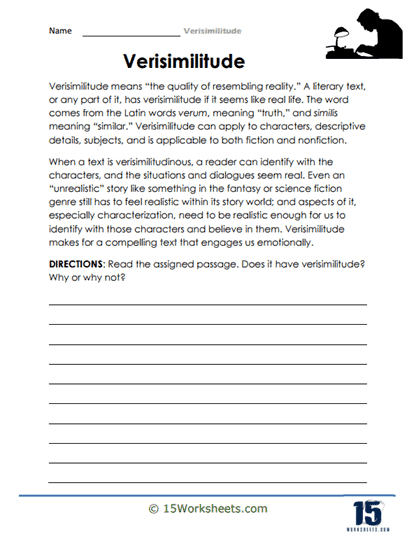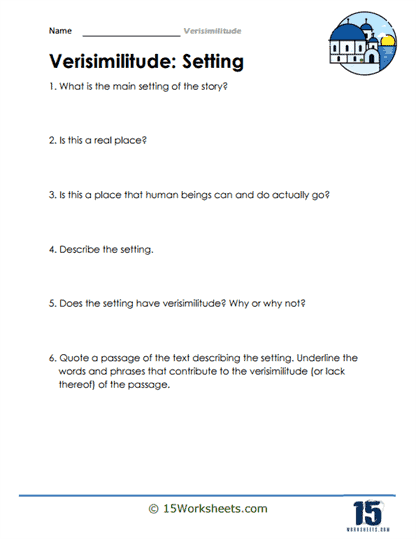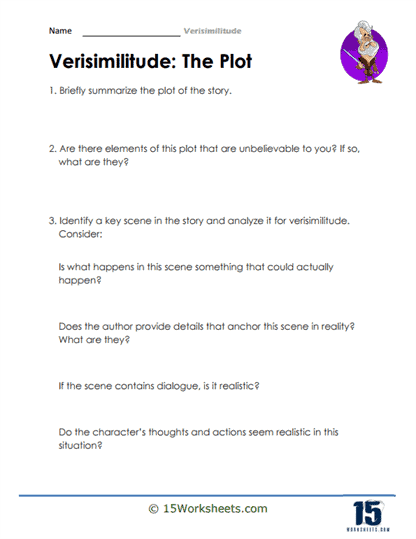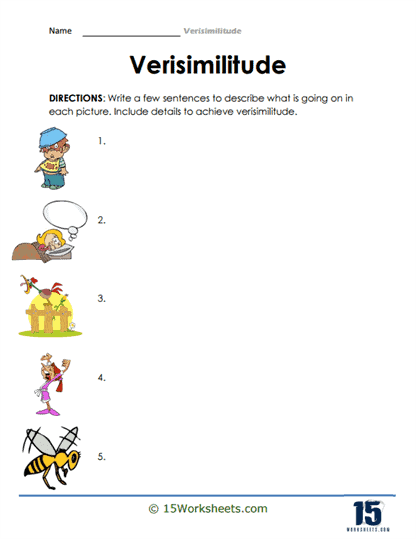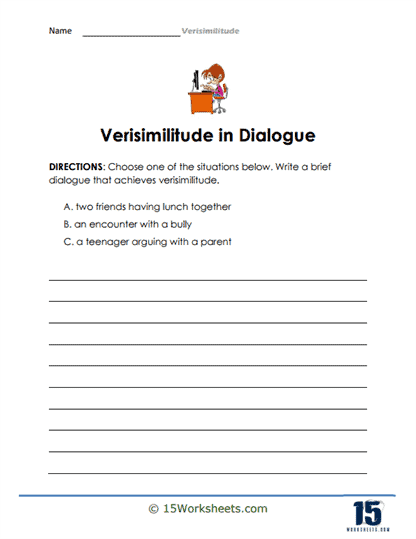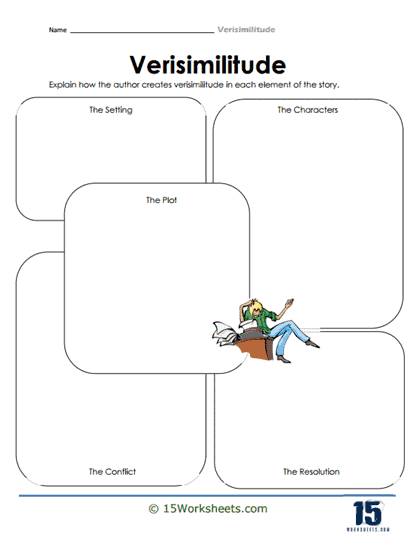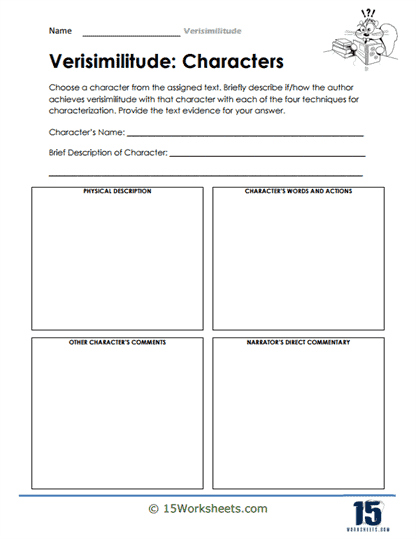Verisimilitude Worksheets
About These 15 Worksheets
These worksheets will enhance students’ comprehension and application of verisimilitude in literary contexts. Verisimilitude, a literary concept, refers to the semblance of truth or the appearance of reality that authors create in their work to make it more believable to the reader. By incorporating realistic elements, authors aim to engage readers more deeply, allowing them to suspend disbelief and immerse themselves in the narrative. These worksheets help students recognize, analyze, and employ verisimilitude in both their interpretation of texts and their own writing, thereby improving their understanding of language arts and reading skills.
Types of Exercises
Verisimilitude worksheets encompass a variety of exercises, each designed to target specific aspects of verisimilitude and its role in literature:
Identification – These tasks ask students to identify elements of verisimilitude within a given passage or text. Students learn to distinguish between realistic and fantastical elements, enhancing their analytical skills.
Comparison Tasks – In these exercises, students compare passages with high and low levels of verisimilitude. This not only sharpens their analytical abilities but also deepens their understanding of how verisimilitude affects reader engagement.
Creation Activities – Students are prompted to write their own short stories or passages employing verisimilitude. This fosters creativity and allows students to practice incorporating realistic details into their writing.
Discussion Prompts – Worksheets may include prompts for class discussions on the effectiveness of verisimilitude in specific texts or its impact on the reading experience. This encourages critical thinking and verbal expression.
Detail Enhancement Exercises – These tasks involve revising a given passage to increase its verisimilitude through the addition of realistic details, dialogues, or settings, helping students to practice refining texts for greater believability.
Analytical Essays – Students may be asked to write essays analyzing the use of verisimilitude in a novel, short story, or poem, focusing on how it contributes to the work’s overall effect. This develops their ability to construct coherent arguments and supports deeper textual engagement.
Multimedia Comparisons – Exercises that involve comparing the verisimilitude in written texts with their adaptations in film or other media can help students understand how different mediums handle realism and believability.
The Benefits of These Worksheets
Engaging with verisimilitude worksheets offers numerous benefits for students, significantly enhancing their language arts and reading skills:
Enhanced Critical Thinking – By analyzing how verisimilitude is achieved and its effect on the narrative, students develop critical thinking skills that are applicable beyond literary analysis, fostering a more nuanced understanding of the world.
Improved Writing Skills – Learning to incorporate verisimilitude in writing helps students create more engaging and believable narratives, enhancing their storytelling abilities and making their writing more compelling to readers.
Deeper Textual Engagement – Understanding the role of verisimilitude in literature enhances students’ ability to engage deeply with texts, leading to a more fulfilling reading experience and a greater appreciation of literary art.
Increased Empathy and Understanding – Through the exploration of realistic characters, settings, and scenarios, students can develop empathy and a better understanding of diverse human experiences and perspectives.
Greater Appreciation for Detail – Focusing on verisimilitude cultivates an appreciation for the importance of detail in creating a believable narrative, encouraging students to pay closer attention to the nuances of text and context.
Strengthened Analytical Abilities – The analysis of verisimilitude in literature sharpens students’ analytical skills, enabling them to discern subtleties in texts and evaluate authors’ techniques more effectively.
Encouragement of Active Reading – The identification and analysis of verisimilitude components encourage active reading practices, as students learn to look for and reflect on the elements that contribute to the realism of a narrative.
What is the Literary Device of Verisimilitude?
Verisimilitude is a crucial literary device that refers to the appearance of truth or realism in a work of fiction. It is the quality that convinces readers they are reading about a real world with plausible interactions and events, even if that world is entirely fictional. Authors use verisimilitude to make their stories more believable, engaging, and relatable, allowing readers to immerse themselves fully in the narrative. It bridges the gap between fiction and reality, enhancing the reader’s suspension of disbelief and fostering a deeper connection with the text.
The main defining feature of verisimilitude is its ability to render a narrative – no matter how fantastical or remote from the reader’s experience – in a manner that feels authentic and credible. This is achieved through the meticulous construction of the story’s setting, characters, actions, and events in a way that mirrors the complexities and nuances of real life. Verisimilitude demands a balance between the imaginative elements of fiction and the recognizable aspects of reality, creating a seamless blend that resonates with the reader’s sense of the world.
Verisimilitude in literature is characterized by several key aspects:
Detailed Settings – Rich, well-developed settings that provide a convincing backdrop for the narrative, including geographic, historical, and social environments that feel tangible.
Complex Characters – Characters with depth, flaws, and personal growth that mirror real human psychology and behavior.
Logical Plot Development – Events and actions within the story that follow a logical sequence, ensuring that even the most unexpected twists seem plausible within the narrative’s context.
Consistent Internal Rules – Especially in genres like fantasy or science fiction, the creation of a world with its own consistent rules and logic that, once established, are not broken.
Realistic Dialogue – Conversations between characters that reflect how people actually speak, including the use of dialects, idioms, and speech patterns appropriate to their backgrounds.
Attention to Detail – The inclusion of specific, often minute, details that add depth and authenticity to the narrative, making the fictional world more vivid and believable.
Examples of Verisimilitude in Literature
“Madame Bovary” by Gustave Flaubert – Flaubert’s novel is renowned for its detailed portrayal of 19th-century French provincial life, providing a vivid backdrop against which the story of Emma Bovary unfolds. Flaubert meticulously crafts each setting, from the Bovary household’s furnishings to the layout of the towns, infusing the narrative with a palpable sense of place. The characters, especially Emma, are portrayed with deep psychological complexity, making their desires, disillusionments, and actions convincingly real. Flaubert’s commitment to the principle of finding “le mot juste” (the exact word) further adds to the verisimilitude of the narrative, as each word is chosen to precisely convey the intended meaning, emotion, or image.
“To Kill a Mockingbird” by Harper Lee – Lee’s novel is set in the racially charged atmosphere of the American South in the 1930s, a setting she brings to life with rich detail and complexity. The characters, particularly Scout, Atticus, and Tom Robinson, are portrayed with depth and nuance, reflecting the varied human responses to the social and moral dilemmas of their time. The narrative’s events, from the trial of Tom Robinson to the children’s encounters with Boo Radley, unfold with a logic and naturalness that maintain the story’s credibility, even as it addresses profound themes of racism, innocence, and morality.
“1984” by George Orwell – Despite being a work of dystopian fiction, Orwell’s novel achieves a high degree of verisimilitude through its detailed depiction of a totalitarian society. The setting, characterized by pervasive surveillance, government propaganda, and public mind control, is meticulously constructed to reflect the logical extension of totalitarian principles. The characters, including Winston Smith and Julia, navigate this world in ways that highlight their psychological realism and the impact of the regime on individual thought and behavior. Orwell’s use of Newspeak, a language designed to limit freedom of thought, adds another layer of realism to the narrative, demonstrating how language can shape and restrict human experience.
The Effect of Verisimilitude on the Reader
The use of verisimilitude in literature has a profound impact on the reader, affecting their engagement with the text and their emotional and intellectual responses:
Increased Immersion – Verisimilitude draws readers into the story, making the fictional world feel as real and complex as the one they inhabit. This deepens their emotional investment in the characters and events.
Enhanced Believability – By making the narrative’s elements feel authentic, verisimilitude allows readers to suspend their disbelief more fully, enhancing their acceptance of and engagement with the story, even when it ventures into fantastical or unfamiliar territory.
Encouraged Empathy – Realistic characters and settings foster empathy in readers, as they can more easily see themselves or recognize the human condition within the story’s framework.
Stimulated Reflection – A believable narrative encourages readers to reflect on the themes and issues presented, relating them to their own experiences and the broader world.


